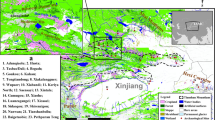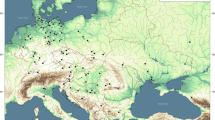Abstract
Over the past decade, increasing attention to the recovery and identification of plant microfossil remains from archaeological sites located in lowland South America has significantly increased knowledge of pre-Columbian plant domestication and crop plant dispersals in tropical forests and other regions1,2,3,4. Along the Andean mountain chain, however, the chronology and trajectory of plant domestication are still poorly understood for both important indigenous staple crops such as the potato (Solanum sp.) and others exogenous to the region, for example, maize (Zea mays)5,6. Here we report the analyses of plant microremains from a late preceramic house (3,431 ± 45 to 3,745 ± 65 14C bp or ∼3,600 to 4,000 calibrated years bp) in the highland southern Peruvian site of Waynuna. Our results extend the record of maize by at least a millennium in the southern Andes, show on-site processing of maize into flour, provide direct evidence for the deliberate movement of plant foods by humans from the tropical forest to the highlands, and confirm the potential of plant microfossil analysis in understanding ancient plant use and migration in this region.
This is a preview of subscription content, access via your institution
Access options
Subscribe to this journal
Receive 51 print issues and online access
$199.00 per year
only $3.90 per issue
Buy this article
- Purchase on Springer Link
- Instant access to full article PDF
Prices may be subject to local taxes which are calculated during checkout


Similar content being viewed by others
References
Piperno, D. R. & Pearsall, D. M. The Origins of Agriculture in the Lowland Neotropics (Academic, San Diego, 1998)
Piperno, D. R. & Stothert, K. E. Phytolith evidence for early holocene Cucurbita domestication in southwest Ecuador. Science 299, 1054–1057 (2003)
Pearsall, D. M., Chandler-Ezell, K. & Zeidler, J. A. Maize in ancient Ecuador: results of residue analysis of stone tools from the Real Alto site. J. Arch. Sci. 31, 423–442 (2004)
Iriarte, J. et al. Evidence for cultivar adoption and emerging complexity during the mid-Holocene in the La Plata basin. Nature 432, 614–617 (2004)
Burger, R. L. & Van der Merwe, N. J. Maize and the origin of highland Chavin civilization: an isotopic perspective. Am. Anthropol. 92, 85–95 (1990)
Hastorf, C. A. in The Prehistory of Food (eds Gosden, C. & Hather, J. G.) 35–58 (Routledge, London, 1998)
Jennings, J. Prehistoric Imperialism And Cultural Development In The Cotahuasi Valley, Peru. Dissertation, Univ. California Santa Barbara (2002)
Burger, R. L., Mohr Chávez, K. L. & Chávez, S. J. Through the glass darkly: prehispanic obsidian procurement and exchange in southern Peru and northern Bolivia. J. World Prehistory 14, 267–362 (2000)
Sandweiss, D. H. et al. Quebrada Jaguay: early maritime adaptations in South America. Science 281, 1830–1832 (1998)
Pulgar Vidal, J. Geografía del Perú 9th edn (PEISA, Lima, 1987)
Trawick, P. B. The Struggle for Water in Peru: Comedy and Tragedy in the Andean Commons (Stanford Univ. Press, Stanford, 2002)
Malpass, M. A. & Stothert, K. E. Evidence for preceramic houses and household organization in western South America. Andean Past 3, 137–163 (1992)
Piperno, D. R. Phytoliths: a Comprehensive Guide for Archaeologists and Paleoecologists (AltaMira, Lanham, MD, In the press)
Perry, L. Starch analyses reveal the relationship between tool type and function: an example from the Orinoco valley of Venezuela. J. Arch. Science 31, 1069–1081 (2004)
Perry, L. Reassessing the traditional interpretation of ‘manioc’ artifacts in the Orinoco Valley of Venezuela. Latin Am. Ant. 16, 409–426 (2005)
Piperno, D. R., Ranere, A. J., Holst, I. & Hansell, P. Starch grains reveal early root crop horticulture in the Panamanian tropical forest. Nature 407, 894–897 (2000)
Fannon, J. E., Hauber, R. J. & BeMiller, J. N. Surface pores of starch granules. Cereal Chem. 69, 284–288 (1992)
Leach, H. W. & Schoch, T. J. Structure of the starch granule II. Action of various amylases on granular starches. Cereal Chem. 38, 34–46 (1961)
Haas, J., Pozorski, S. & Pozorski, T. (eds) The Origins and Development of the Andean State (Cambridge Univ. Press, Cambridge, 1987)
Wilson, D. J. Prehispanic Settlement Patterns in the Lower Santa Valley, Peru (Smithsonian Institution Press, Washington DC, 1988)
Moseley, M. E. The Incas and Their Ancestors 2nd edn (Thames & Hudson, London and New York, 2001)
Ugent, D., Pozorski, S. & Pozorski, T. Archaeological potato tuber remains from the Casma Valley of Peru. Econ. Bot. 36, 182–192 (1982)
Lathrap, D. W. in Variation in Anthropology: Essays in Honor of John C. McGregor (eds Lathrap, D. W. & Douglas, J.) 91–105 (Illinois Archaeological Survey, Urbana, 1973)
Lathrap, D. W. The antiquity and importance of long distance trade relationships in the moist tropics of pre-Columbian South America. World Arch. 5, 170–186 (1973)
Brush, S. Mountain Field and Family: The Economy and Human Ecology of an Andean Valley (Univ. Pennsylvania Press, Philadelphia, 1977)
Babot, M. del P. in Phytolith and Starch Research in the Australian-Pacific-Asian Regions: the State of the Art (eds Hart, D. M. & Wallis, L. A.) 69–81 (Pandanus Books, Canberra, 2003)
Fullagar, R., Loy, T. & Cox, S. in A Closer Look: Recent Australian Studies of Stone Tools (ed. Fullagar, R.) 49–60 (Archaeological Computing Laboratory, Univ. Sydney, Sydney, 1998)
McCormac, F. G. et al. SHCal04 Southern Hemisphere calibration 0–11.0 cal kyr bp. Radiocarbon 46, 1087–1092 (2004)
Reimer, P. J. et al. IntCal04 terrestrial radiocarbon age calibration, 0–26 cal kyr bp. Radiocarbon 46, 1029–1058 (2004)
Stuiver, M. & Reimer, P. J. Extended 14C data base and revised CALIB 3.0 14C age calibration program. Radiocarbon 35, 215–230 (1993)
Acknowledgements
D. Goldstein provided modern Andean plant materials for comparative purposes. This work was supported by a grant from the Heinz Charitable Trust Latin American Archaeology Program, and funding from FERCO and the Office of the Provost, Ithaca College, and from the Smithsonian Tropical Research Institute and the Smithsonian National Museum of Natural History.
Author information
Authors and Affiliations
Corresponding author
Ethics declarations
Competing interests
Reprints and permissions information is available at npg.nature.com/reprintsandpermissions. The authors declare no competing financial interests.
Supplementary information
Supplementary Figure 1
Clump of hard endosperm type maize starch granules (Cat 33 segunda). (PDF 53 kb)
Supplementary Figure 2
Soft endosperm type maize starch granule (Cat 11 b). (PDF 92 kb)
Supplementary Figure 3
Variant 1 cross phytolith of maize (Cat 33 segunda). (PDF 35 kb)
Supplementary Figure 4
Possible Solanum sp. starch granule (Cat 30 b). (PDF 11 kb)
Supplementary Methods
This file contains additional details of the methods used in this study. (DOC 22 kb)
Rights and permissions
About this article
Cite this article
Perry, L., Sandweiss, D., Piperno, D. et al. Early maize agriculture and interzonal interaction in southern Peru. Nature 440, 76–79 (2006). https://doi.org/10.1038/nature04294
Received:
Accepted:
Issue Date:
DOI: https://doi.org/10.1038/nature04294
This article is cited by
-
The role of farming and fishing in the rise of social complexity in the Central Andes: a stable isotope perspective
Scientific Reports (2024)
-
Pre-Hispanic terrace agricultural practices and long-distance transfer of plant taxa in the southern-central Peruvian Andes revealed by phytolith and pollen analysis
Vegetation History and Archaeobotany (2024)
-
Exposure assessment of 170 pesticide ingredients and derivative metabolites in people from the Central Andes of Peru
Scientific Reports (2022)
-
Eight Decades of Dalbulus maidis (DeLong & Wolcott) (Hemiptera, Cicadellidae) in Brazil: What We Know and What We Need to Know
Neotropical Entomology (2022)
-
Joint analysis of days to flowering reveals independent temperate adaptations in maize
Heredity (2021)
Comments
By submitting a comment you agree to abide by our Terms and Community Guidelines. If you find something abusive or that does not comply with our terms or guidelines please flag it as inappropriate.



